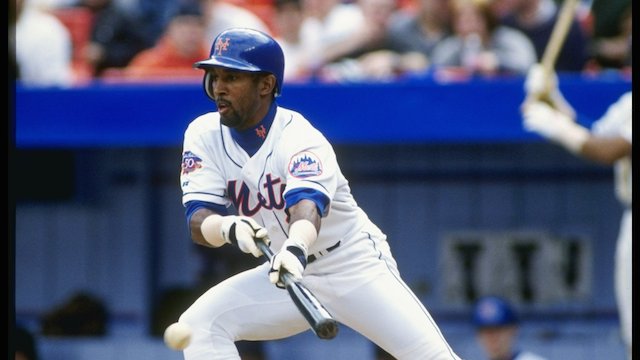
Lately in this space, I’ve been writing about players who spent time with the New York Mets, had some good years, but ultimately had better years with another club. There are a handful of players, however, that played most of the careers with other teams, then played for the Mets for a short while, and put up career best numbers while with New York.
One such player is Lance Johnson, whose 1996 season was among the five or ten best in Mets history.
Johnson came up in the St. Louis Cardinals organization, but was soon traded to the Chicago White Sox. He spent eight seasons with the South Siders, and because his ability to hit to contact paired with great speed, he became an extra-base hitting machine.
He led the AL in triples from 1991-1994 becoming the first player in MLB history to lead his league in three-baggers for four consecutive years. He is also part of a handful of players in history who collected three triples in one game, part of a six-for-six performance against the Minnesota Twins in 1995.
Johnson was a capable and versatile outfielder who played all three positions with Chicago, but was best known for his exploits in center. He became a free agent at the end of the 1995 season and signed with the Mets on December 14, 1995. His 1996 season with New York is widely considered to be Johnson’s best as a big leaguer.
It is often overshadowed, however, by Bernard Gilkey’s season as he too put together a terrific ’96 campaign. Gilkey came to New York in a trade and coupled with Johnson, created one of the best outfield pairings in baseball. They were worth a combined 14 fWAR in 1996.
Although Gilkey hit more for power, Johnson just flat-out hit. Lance led the league in knocks with 227 and coupled with his AL leading 186 hits in 1995, became the only player in the history of Major League Baseball to lead both leagues in hits, as well as at bats, and triples.
Johnson made his first and only appearance in the All-Star game in 1996. He hit .322/.345/.473 in a surprising first-half performance. His second half was even better, slashing a monster .346/.382/.487.
Overall in his 1996 campaign, he hit a remarkable .333/.362/.479 with a 6.4 fWAR. The .333 BA was one of the best in Mets history.
The records did not end there as Johnson set five Mets single-season marks in 1996. He set the record for at-bats with 682, which he held until 2005 after a young Jose Reyes would break that mark. Johnson set the record for runs scored with 117, with Edgardo Alfonzo surpassing that 1999.
He had the most total bases in franchise history with 327, until broke that David Wright in 2007. Johnson’s records for triples (21) and hits (227) are still Mets single-season records.
Johnson was also one of only two Mets to steal over 50 bases in a season, with Mookie Wilson the other.
Although his 1996 was remarkable, the Mets had other glaring weaknesses that resulted in a 71-91 season. They finished in fourth place in the NL East, a full 25 games behind the Atlanta Braves.
Hope began to blossom after, however, the off-season acquisition of John Olerud. The Mets would contend in 1997, and looked to bolster their bullpen at the trade deadline sending Lance Johnson to the Chicago Cubs for Brian McRae, Mel Rojas, and Turk Wendell.
Johnson was having a nice year in ’97 with New York (.309/.385/.404 in 72 games), but the same could not be said for the players sent to the Mets, all of whom having poor August and Septembers. Wendell would go onto to be an important cog in the Mets bullpen during their playoff runs, but you can still consider the “what if” Johnson remained a Met at least until the 1997 off-season.
It’s tough to argue though, that the then 33 year-old would never have more trade value after the impressive 1 1/2 years he put together in Queens. Whatever the case, he was gone, leaving memories of a terrific season with records that still stand.
Johnson was with the Cubs until 2000 when he finished his career with the Yankees. He appeared in only 30 games, but was still given a World Series ring. He currently resides in Alabama with his wife.
It could be said of Johnson, ‘we hardly got to know you.’ But his short stay in Flushing should not be overlooked or forgotten.
Though his team performed poorly in 1996, his individual statistics were impressive. He was one of the few reasons to see a team that finished 20 games below .500.
It was refreshing to see a player excel in his brief time in New York.















